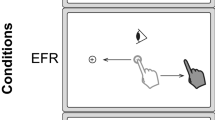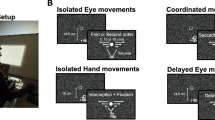Abstract.
The existence of a temporal gap between the offset of a fixation target and the onset of a peripheral target generally reduces the saccadic and manual reaction time in response to the peripheral target. Using a double-step paradigm, the present experiment investigated whether a temporal gap between the extinction of the first target and the presentation of the second target can help in reducing the time to trigger the corrective eye movements and to correct the arm trajectory towards the final target position. A gap was introduced between the presentation of the initial target and a new unexpected goal-target during the movement. The results replicated the gap effect for the corrective saccade to the second target, but revealed an opposite effect for the correction of the reaching movements as the arm correction occurred later in the Gap than in the No-Gap conditions. These results suggest that the information available for the arm motor system to correct the trajectory in relation to the second target was different in the Gap and No-Gap conditions. In the No-Gap condition, the correction of reaching movements would be based on retinal errors between the first and the second targets whereas, in the Gap condition, the correction would be based on information derived from the corrective saccade-related signals to the second target.
Similar content being viewed by others
Author information
Authors and Affiliations
Additional information
Electronic Publication
Rights and permissions
About this article
Cite this article
Boulinguez, P., Blouin, J. & Nougier, V. The gap effect for eye and hand movements in double-step pointing. Exp Brain Res 138, 352–358 (2001). https://doi.org/10.1007/s002210100718
Received:
Accepted:
Issue Date:
DOI: https://doi.org/10.1007/s002210100718




